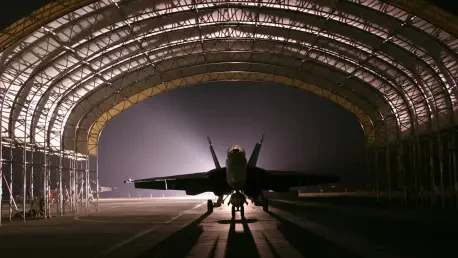In an era where global travel demands are soaring to unprecedented heights, the aviation industry stands at a crossroads, compelled to evolve with groundbreaking innovations that promise to redefine air travel. Every year, millions of passengers board flights expecting seamless experiences, while airlines grapple with the dual challenge of maintaining profitability and meeting stringent safety and environmental standards. Technology has emerged as the cornerstone of this transformation, driving efficiencies and enhancing customer satisfaction in ways previously unimaginable. From predictive maintenance systems that prevent delays to digital platforms that personalize passenger interactions, the sector is witnessing a revolution fueled by smart solutions. This wave of change not only addresses operational hurdles but also positions airlines to thrive in a fiercely competitive market, setting the stage for a deeper exploration of how these advancements are reshaping the skies.
Enhancing Operational Efficiency
Streamlining Maintenance with Predictive Analytics
The push for operational excellence in aviation has led to the adoption of predictive maintenance, a technology-driven approach that anticipates mechanical issues before they disrupt schedules. By harnessing vast amounts of data from aircraft sensors, airlines can identify potential problems in engines or other critical systems, scheduling repairs during planned downtime rather than reacting to unexpected failures. This proactive strategy significantly reduces the risk of costly delays and cancellations, ensuring that fleets remain reliable and safe for passengers. Beyond the immediate benefits, predictive maintenance cuts maintenance costs by optimizing resource allocation, allowing technicians to focus on targeted interventions. The ripple effect of this innovation is felt across the industry, as minimized disruptions bolster passenger trust and reinforce an airline’s reputation for punctuality, proving that data analytics is no longer optional but essential for staying competitive in a fast-paced environment.
Optimizing Ground Support Operations
Ground support operations, often the unsung heroes of aviation, are undergoing a quiet but impactful transformation through specialized equipment and digital tools. Engine stands and automated systems for baggage handling streamline workflows at airports, reducing turnaround times between flights and ensuring aircraft are ready for their next journey with minimal delay. Digital dashboards provide real-time updates to ground crews, enabling swift coordination and reducing the likelihood of errors during high-pressure situations. These advancements not only enhance efficiency but also contribute to cost savings by minimizing labor-intensive processes and preventing damage to expensive equipment. As airlines scale these solutions across global hubs, the cumulative effect is a smoother operation that passengers rarely notice but always benefit from, highlighting how behind-the-scenes innovations can have a profound impact on the overall travel experience.
Revolutionizing Passenger Experience and Business Models
Digital Transformation for Seamless Travel
Digital transformation has become a game-changer in how airlines interact with passengers, creating a more connected and personalized travel journey. Cloud-based platforms integrate everything from booking to boarding, allowing for real-time updates on flight statuses and gate changes through mobile apps that keep travelers informed at every step. Artificial intelligence plays a pivotal role by tailoring communications, such as sending customized offers or alerts based on individual preferences, which enhances customer satisfaction. Meanwhile, AI-driven route optimization reduces fuel consumption, aligning with sustainability goals while cutting costs. This holistic adoption of digital tools fosters agility, enabling airlines to adapt quickly to disruptions like weather events or regulatory shifts, ensuring that passengers experience fewer inconveniences. The shift toward a tech-savvy approach signals a broader trend where convenience and efficiency define modern air travel.
Revenue Strategies through Dynamic Pricing
Beyond enhancing passenger experiences, airlines are reimagining revenue generation through innovative pricing models that adapt to market dynamics. Dynamic pricing systems, powered by sophisticated algorithms, adjust ticket fares in real time based on demand, competitor pricing, and seasonal trends, maximizing income from each flight. Data analytics also uncovers ancillary revenue opportunities, such as fees for priority boarding or in-flight purchases, which have become significant profit drivers. Personalized offers, often tied to loyalty programs, encourage repeat business by rewarding frequent flyers with tailored perks that increase spending. This strategic balance between commercial objectives and customer value ensures that profitability does not come at the expense of satisfaction. As these models evolve, they reflect a deeper understanding of traveler behavior, positioning airlines to capitalize on emerging trends while maintaining a competitive edge in a crowded marketplace.
Workforce Training with Cutting-Edge Tools
The aviation workforce, from pilots to ground staff, is being empowered through innovative training solutions that prioritize safety and adaptability. Virtual reality and augmented reality simulations offer immersive environments where employees can practice handling complex scenarios, such as emergency evacuations or technical malfunctions, without real-world risks. These technologies accelerate learning curves and ensure readiness for high-stakes situations, enhancing overall operational standards. Additionally, workforce management software optimizes staffing levels, ensuring compliance with labor regulations while minimizing errors in scheduling. Such tools also boost employee engagement by providing clear career development paths and access to continuous learning. The focus on tech-driven training underscores a commitment to maintaining excellence in an industry where human expertise remains irreplaceable, even as automation grows. This investment in people ultimately translates to safer, more reliable services for travelers worldwide.
Reflecting on Industry-Wide Impact
Building a Sustainable Future
Looking back, the aviation sector has demonstrated remarkable resilience as it embraced technological advancements to address multifaceted challenges over recent years. Predictive maintenance and digital platforms have curtailed operational inefficiencies, while dynamic pricing and personalized services redefined how airlines connected with passengers. Workforce training evolved through virtual simulations, ensuring that safety and adaptability remained at the forefront of industry priorities. These strides collectively laid a robust foundation for sustainable growth, balancing profitability with environmental and customer-focused goals. The integration of AI and data analytics proved instrumental in optimizing everything from fuel usage to fare structures, reflecting a mature approach to innovation. As the industry navigated this transformative period, it became evident that technology was not merely a tool but a strategic imperative, shaping a more agile and responsive aviation landscape for all stakeholders involved.
Charting the Path Forward
Reflecting on past achievements, the next steps for airlines involve deepening the integration of these innovations while exploring uncharted territories in sustainability and customer engagement. Investing in greener technologies, such as alternative fuels and electric aircraft prototypes, should be prioritized to meet global emission targets. Expanding digital ecosystems to offer even more seamless, contactless travel options can further elevate passenger trust and convenience. Collaborations between airlines and tech firms could accelerate the development of next-generation solutions, from smarter airports to enhanced cybersecurity for digital platforms. Continuous upskilling of the workforce through advanced tools will ensure readiness for future disruptions, maintaining the high standards travelers expect. By focusing on these actionable strategies, the aviation industry can build on its recent progress, fostering a future where efficiency, safety, and satisfaction soar to new heights through relentless innovation.









